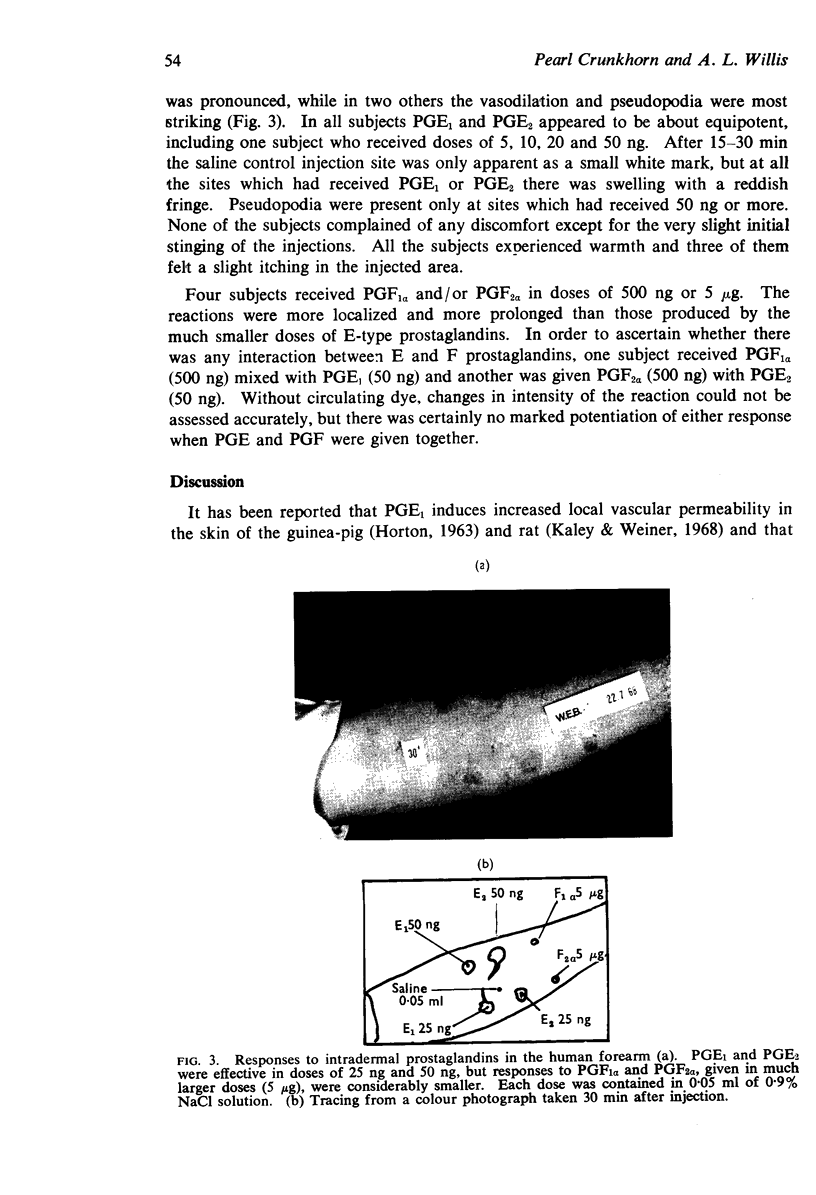Abstract
1. The effects of intradermally injected prostaglandins (PGs) E1, E2, F1α and F2α have been examined in the rat and in man.
2. PGE1 and PGE2 caused an increase in local vascular permeability in rat skin; their potency was comparable with that of other putative mediators of inflammation (histamine, bradykinin, and 5-hydroxytryptamine), but PGF1α and PGF2α were only slightly active even at a dose of 1 μg.
3. Prior administration of mepyramine and methysergide, or depletion of skin mast cell amines with compound 48/80, indicated that PGE2 exerted its permeability effect in the rat by a release of mast cell amines.
4. Nanogramme doses of PGE1 and PGE2 or microgramme doses of PGF1α and PGF2α injected intradermally into the human forearm induced weal and flare responses.
5. It is concluded that prostaglandins E1 and E2 can act as intermediates in the production of hyperaemia and oedema resulting from cell damage in the rat and man.
Full text
PDF







Images in this article
Selected References
These references are in PubMed. This may not be the complete list of references from this article.
- BROCKLEHURST W. E., HUMPHREY J. H., PERRY W. L. The role of histamine in cutaneous antigen-antibody reactions in the rat. J Physiol. 1955 Aug 29;129(2):205–224. doi: 10.1113/jphysiol.1955.sp005348. [DOI] [PMC free article] [PubMed] [Google Scholar]
- Bartels J., Vogt W., Wille G. Prostaglandin release from and formation in perfused frog intestine. Naunyn Schmiedebergs Arch Exp Pathol Pharmakol. 1968;259(2):153–154. doi: 10.1007/BF00537747. [DOI] [PubMed] [Google Scholar]
- Bergström S., Carlson L. A., Ekelund L. G., Orö L. Cardiovascular and metabolic response to infusions of prostaglandin E1 and to simultaneous infusions of noradrenaline and prostaglandin E1 in man. Prostaglandin and related factors 35. Acta Physiol Scand. 1965 Aug;64(4):332–339. doi: 10.1111/j.1748-1716.1965.tb04187.x. [DOI] [PubMed] [Google Scholar]
- HOGBERG B., UVNAS B. The mechanism of the disruption of mast cells produced by compound 48/80. Acta Physiol Scand. 1957 Dec 31;41(4):345–369. doi: 10.1111/j.1748-1716.1957.tb01533.x. [DOI] [PubMed] [Google Scholar]
- HORTON E. W. ACTION OF PROSTAGLANDIN E1 ON TISSUES WHICH RESPOND TO BRADYKININ. Nature. 1963 Nov 30;200:892–893. doi: 10.1038/200892b0. [DOI] [PubMed] [Google Scholar]
- Pickles V. R. The prostaglandins. Biol Rev Camb Philos Soc. 1967 Nov;42(4):614–652. doi: 10.1111/j.1469-185x.1967.tb01532.x. [DOI] [PubMed] [Google Scholar]
- Piper P. J., Vane J. R. Release of additional factors in anaphylaxis and its antagonism by anti-inflammatory drugs. Nature. 1969 Jul 5;223(5201):29–35. doi: 10.1038/223029a0. [DOI] [PubMed] [Google Scholar]
- Willis A. L. Parallel assay of prostaglandin-like activity in rat inflammatory exudate by means of cascade superfusion. J Pharm Pharmacol. 1969 Feb;21(2):126–128. doi: 10.1111/j.2042-7158.1969.tb08213.x. [DOI] [PubMed] [Google Scholar]



